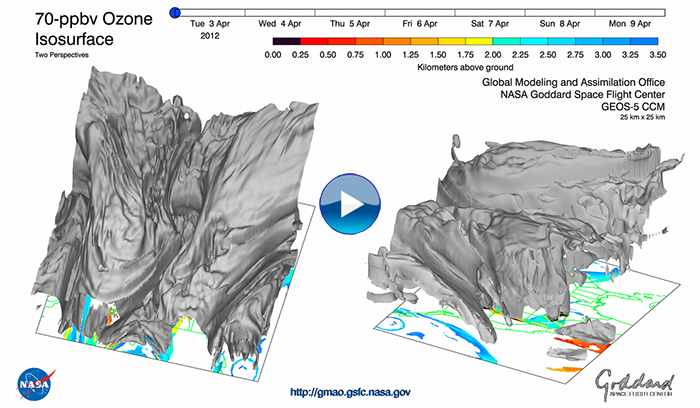Stratospheric Ozone Impacts Surface Air Quality in a High-Resolution Global Simulation
J. Eric Nielsen, Bryan Duncan, Lesley Ott, and Steven Pawson February 2014
The GMAO has recently expanded its high-resolution modeling capabilities to include a comprehensive stratosphere/troposphere chemistry mechanism in GEOS-5. This model version has been run on NASA’s High Performance Computing systems to explore the global structure of chemical species at a spatial resolution of 25 km, which until recently was unprecedented. Including both tropospheric and stratospheric chemical processes allows the model to simulate the detailed chemical signatures of important transient weather events, including typhoons and hurricanes and, as described here, stratospheric intrusions.
A stratospheric intrusion occurs when stratospheric air "folds" into the troposphere and descends toward the surface. Over the mountainous western United States, intrusions can reach the ground because of the high elevation. They are less frequent at low-elevation surface sites on the East Coast. Since stratospheric air has elevated ozone concentrations compared to clean, tropospheric air, an intrusion leads to surface ozone values that are comparable with those found in local pollution events. Such intrusions can thus raise ground-level ozone concentrations above the Environmental Protection Agency’s (EPA) National Ambient Air Quality Standards (NAAQS) threshold.
The animation shows the GEOS-5 simulation of a stratospheric intrusion that impacted several western states on April 6 and 7, 2012. The two perspectives show the 70 parts-per-billion-by-volume (ppbv) ozone isosurface, which in the early spring* is a marker of stratospheric air that usually lies very close to the tropopause (about 7-8km above the surface). Both perspectives focus on the United States and the western Pacific Ocean, with the left view looking down and generally from NW to SE, and the right view looking SW to NE to start, then later panning clockwise to look toward the N and NW. On the underlying maps, the colors indicate the proximity of the 70-ppbv isosurface to the ground, when it comes to within 3.5 km. The color legend is near the top. The progress bar shows the time.
With the vertical axis highly exaggerated, the view from above (left) allows us to follow the undulations of the isosurface, which can be loosely regarded as a proxy for the tropopause and to look "down into" the tropopause folds. These structures are generated by weather systems as they move across the continent. The "underside" of the isosurface (right) gives us an indication of the elevation of the stratospheric air and how it behaves after descending. As the animation recycles, it becomes easier to infer which features on the left belong to those on the right.
The animation shows that high-resolution circulation-chemistry modeling with GEOS-5 has the potential to illuminate the complex dynamics of intrusions, and to enable global inventories of their frequency, seasonality, and life cycles. With such high resolution, the model appears to accurately simulate the evolution of the curtains, tubes, and filaments of stratospheric air as they are stretched and twisted by the sheared wind fields, and are eventually mixed or dispersed into the surrounding tropospheric air. In addition, the preservation of ozone gradients is important for maintaining chemical processing over the correct temporal and spatial scales and for assessing how intrusions impact the tropospheric ozone budget.
Relative to clean tropospheric air, stratospheric air also has lower carbon monoxide (CO) concentrations, and is dryer. These two characteristics, along with elevated ozone, are used to detect intrusions, which typically occur in spring and are associated with storm systems. However, the identification of intrusions with only surface monitoring is challenging because intrusions are episodic and have a transient and localized nature, and because the surface measurements available to diagnose their presence are sparse. Therefore, additional data from ozonesondes and satellites, together with model simulations can now help demonstrate when intrusions are the cause of ozone exceedances of the NAAQS. The EPA recently formed a working group of scientists and air quality managers from local, state, and federal agencies to provide support for identifying intrusions using a combination of models, surface observations, and satellite data. One reason is because stratospheric intrusions will more frequently cause ozone exceedances as the NAAQS ozone standard is lowered.
* Later in spring, and especially during the summer, photochemistry becomes active and produces ozone near the ground with concentrations well in excess of 70 ppbv. In summer, it would be much more difficult, if not impossible, to distinguish stratospheric from tropospheric ozone by simply mapping the isosurface. Upon close inspection, indeed, the animation shows some episodic photochemical ozone in the boundary layer near Los Angeles, Houston, and Miami. But in early April, the amounts are so small as to not confuse the stratospheric interpretation.
The GEOS-5 chemical component was developed in collaboration with the Global Modeling Initiative (GMI, gmi.gsfc.nasa.gov) project and Harvard University. The mechanism includes 71 transported species, 51 short-lived, non-transported species, 321 thermal reactions, and 81 photolytic reactions. Emissions include VOCs, CO, and NO from biomass burning, NO and CO from fossil fuel and biofuel, NO emission from soil, and biogenic emissions of isoprene and monoterpenes.
Reference:
For further information on the impact of stratospheric intrusions on surface air quality, please see:
Lin M., A. M. Fiore , O. R. Cooper , L. W. Horowitz , A. O. Langford , Hiram Levy II , B. J. Johnson , V. Naik , S. J. Oltmans , C. Senff (2012): Springtime high surface ozone events over the western United States: Quantifying the role of stratospheric intrusions, Journal of Geophysical Research, 117, D00V22, doi:10.1029/2012JD018151.


